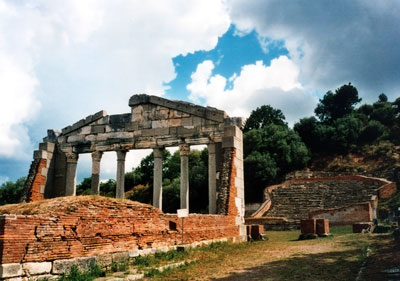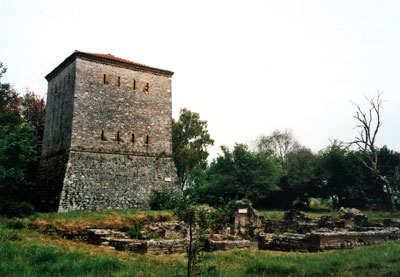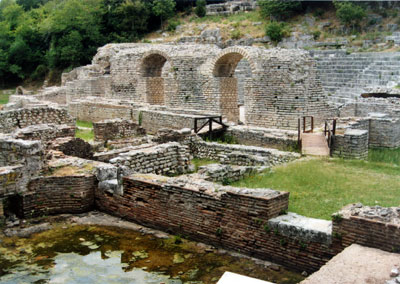Into Albania’s past
This item appears on page 77 of the February 2009 issue.
Not many archaeological sites can claim they were founded by survivors from the Trojan War or that they were visited by Aeneas. Butrint can claim both. Butrint, located in southern Albania close to the Greek border, is the country’s best-known archaeological site. It also is on the UNESCO list of World Heritage Sites.
Legend ascribes Butrint’s founding to Helenus, son of King Priam of Troy, who was a survivor of the Trojan War. In Virgil’s Aeneid, written in the first century BC, a thousand years after the events it describes, the hero Aeneas visits Butrint in his wanderings after the fall of Troy: “I gave the order to man the thwarts and leave this harbor; all obeyed, swept oars in rivalry. We left Phaeacia’s airy heights, coasting Epirus, drawn to Buthrotum, a Chaonian harbor.” (Aeneid, Book 3)
Buthrotum was the Latin name for this ancient city with roots that go back perhaps as far as the 12th century BC. Certainly by the seventh century BC, Buthrotum was a fortified Illyrian town with an acropolis and an encircling stone wall. By the fourth century BC, this wall stretched over half a mile and was pierced by six gates. A temple to Asclepius, the god of medicine, was built about this time, attracting pilgrims who came with offerings.
The Romans arrived in 167 BC, although Buthrotum did not become a Roman colony until 30 BC, under Augustus Caesar. An aqueduct, forum and baths were built. Unlike many Roman settlements that disappeared or declined after the fall of Rome in AD 476, Buthrotum expanded, with Byzantine churches built in the fifth and sixth centuries AD.
Byzantines, the Normans of Sicily and Venetians all contended for Buthrotum, with the Venetians successful, beginning a four-century-long domination that lasted from 1386 until Buthrotum was ceded to Napoleon in 1798. The city then became part of the Ottoman empire until Albanian independence in 1912. Buthrotum’s Albanian name is Butrint.
The archaeological site is complex, with ruins from all eras of its occupation, comprising more than 2,500 years in total. But the explanatory signs throughout the site are excellent, providing visitors enough information (in English) to understand what they are seeing. At least 2½ to three hours should be allowed to fully appreciate this ancient city of many layers.
Agora area
The first major area visitors see is the Agora with the Temple of Asclepius, built in the third century BC, one of the earliest structures in Butrint.
Beside this temple is the beautifully preserved Greek-style Theater, built in the third century BC at the foot of the Acropolis. It could seat 2,500 spectators and is still used today for performances.
The “Goddess of Butrint” statue, now in the National Historic Museum in Tirana, was discovered here in 1928. The head of the “goddess” is actually that of the god Apollo, somehow grafted onto the statue of a female body!
Adjacent to the Theater are Roman baths from the second century AD, appropriately enough filled with water at the time of our visit. The rising water table at Butrint is not, however, so good for the other monuments.
A short detour from the main path brings visitors to the ruins of a large structure called the Tri-conch Palace because of the scallop-shaped walls of what once was the palace’s dining room. This palace might have been a private residence or perhaps the Byzantine archbishop’s palace, dating from the sixth century AD when the nearby Baptistry and Basilica also were built.
Byzantine area
Butrint’s Baptistry is one of the most important paleo-Christian sites in the Balkans. Sixteen granite columns surround an in-ground baptismal font that once was heated with water from a hypocaust. Apparently, early Christians here did not have to endure immersion in cold water.
The Baptistry has a mosaic floor inlaid with intricate geometric scrolls as well as birds, fish and animals in profusion. Unfortunately, it’s now covered with sand to protect it, so visitors have to content themselves with photos they find in books or replicas in museums.
From here, visitors can stroll further back into Butrint’s past alongside Illyrian walls constructed of cyclopean blocks of stone in the fifth century BC, at least a thousand years before the Baptistry and Basilica were built.
Entering through the Lion Gate, one of the six gates of the ancient city, with its lintel depicting a lion devouring an ox, visitors can climb the Acropolis. Atop here are the earliest seventh-century-BC remnants of Butrint as well as the medieval castle built much later by the Venetians and now housing a museum. The view from here is panoramic, with a triangular fortress also built by the Venetians in the foreground and Lake Butrint just beyond.
Greek Apollonia
Apollonia, another of Albania’s premier archaeological sites, is also located in southern Albania, about 30 miles from the city of Vlora. It once was one of the two more important Greek colonies in Albania, the other being Dyrrachion, now the modern Adriatic seacoast town of Durrës.
Apollonia was founded by settlers from Greek Corinth about 600 BC and was, in ancient times, a rival with Dyrrachion, itself founded by colonists from Corcyra (Corfu). In 148 BC it was incorporated into the Roman province of Macedonia. In the third century AD it lost its importance when an earthquake shifted the course of the river and the city lost the harbor that had made it an important port.
Unlike at Butrint, nothing is signposted at Apollonia, making it difficult to identify sites, most of which are unreconstructed and lying among brambles and tall grass. Still, it is worthwhile to spend an hour in what once was Apollonia’s Agora, where the magnificent remains of the Bouleuterion and Odeon stand. Both are easy to locate.
The Bouleuterion, built in the second century AD, was the administrative center of the city. What remains — elegant Corinthian columns and an architrave stating that the building was erected by Quintus Villius Crispinus Furius Procolus — gives an idea of the now-vanished grandeur of this city.
Across from the Bouleuterion is the lovely Odeon, built at about the same time as the Bouleuterion and still used for cultural events as it was almost 2,000 years ago. Adjacent is the much older, fourth-century-BC Stoa, a 238-foot-long colonnade lined with insets that once held statues.
Two-and-a-half miles of walls surround Apollonia, some of them 2,600 years old. It is possible for the visitor to hike around them. There’s also an Acropolis, but most of what once was here has long since been incorporated into the houses of nearby villages.
At the entrance to the Apollonia ruins is a 13th-century-AD monastery, Shenmri (St. Mary), displaying artifacts from the site as well as medieval frescoes and stone carvings.
More sites
Besides these two foremost Albanian archaeological sites, my husband and I also visited remnants of the past in three other locations: the immense second-century-AD Roman amphitheater in Durrës; the sixth-century-AD Christian basilica, built on top of an earlier synagogue in Saranda, and, outside Korça, the Kamenica Tumulus, which served as a burial mound from 1200 BC to 600 BC.
There also were the fortresses at Kruju, Gjirokastra, Berat and Shkodra, archaeological sites that are part of Albania’s rich and checkered past.
If you go. . .
Our 14-day trip through Albania in June ’08 was arranged by Original World (Box 446, Mill Valley, CA 94941; 888/367-6147, e-mail inquire@originalworld.com or visit www.originalworldjourneys.co).
Including a private car and driver, accommodations and entrance fees but excluding lunches and dinners, the cost of our land arrangements was $2,342 each. Airfare from New York’s JFK to Tirana, with a stopover in Vienna, cost us an extra $1,800 each on Austrian Airlines.
The hotels in the nine cities we stayed in were adequate. It is worthwhile, however, to consider spending a little extra, if you can, to upgrade to either a better room in a hotel or to a hotel with more charm, as we did in the course of our trip.



